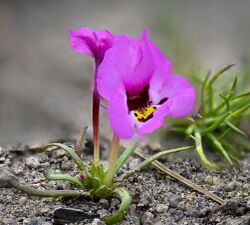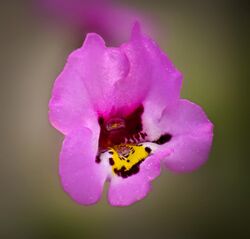Biology:Diplacus angustatus
| Diplacus angustatus | |
|---|---|

| |
| Scientific classification | |
| Kingdom: | Plantae |
| Clade: | Tracheophytes |
| Clade: | Angiosperms |
| Clade: | Eudicots |
| Clade: | Asterids |
| Order: | Lamiales |
| Family: | Phrymaceae |
| Genus: | Diplacus |
| Species: | D. angustatus
|
| Binomial name | |
| Diplacus angustatus (A.Gray) G.L.Nesom
| |
Diplacus angustatus is a species of monkeyflower known by the common names purplelip pansy monkeyflower and narrowleaf pansy monkeyflower.[1][2][3][4]
Distribution
It is endemic to California , where its distribution is scattered around the North Coast Ranges through the San Joaquin Valley and a section of the Sierra Nevada foothills. It grows in moist habitat in open areas, such as vernal pools and meadows, sometimes carpeting an open area with its tiny pink blooms.
Description
Diplacus angustatus is a petite annual herb growing in ground-level tufts with hair-thin stems barely a centimeter tall. Its herbage is green to reddish in color, the paired linear leaves spreading about 1 to 3 centimeters long. The tubular base of the flower is surrounded by a hairy greenish to red calyx of sepals. The flower corolla is pale to bright pink to reddish-purple with one or more large purple spots, and sometimes yellow markings, in the throat. The trumpet-like corolla may be several centimeters long, much longer than the stem on which it is borne.
Research suggests that the population size of this wildflower is positively affected by disturbance of the soil it grows in, especially by the activity of pocket gophers; plants growing on disturbed soil have bigger flowers, fewer plant competitors, and more pollen on their stigmas from greater numbers of neighboring D. angustatus.[5]
References
- ↑ Barker, W.R.; Nesom, G.L.; Beardsley, P.M.; Fraga, N.S. (2012), "A taxonomic conspectus of Phrymaceae: A narrowed circumscriptions for Mimulus, new and resurrected genera, and new names and combinations", Phytoneuron 2012–39: 1–60, http://www.phytoneuron.net/PhytoN-Phrymaceae.pdf
- ↑ Beardsley, P. M.; Yen, Alan; Olmstead, R. G. (2003). "AFLP Phylogeny of Mimulus Section Erythranthe and the Evolution of Hummingbird Pollination". Evolution 57 (6): 1397–1410. doi:10.1554/02-086. PMID 12894947.
- ↑ Beardsley, P. M.; Olmstead, R. G. (2002). "Redefining Phrymaceae: the placement of Mimulus, tribe Mimuleae, and Phryma". American Journal of Botany 89 (7): 1093–1102. doi:10.3732/ajb.89.7.1093. PMID 21665709.
- ↑ Beardsley, P. M.; Schoenig, Steve E.; Whittall, Justen B.; Olmstead, Richard G. (2004). "Patterns of Evolution in Western North American Mimulus (Phrymaceae)". American Journal of Botany 91 (3): 474–4890. doi:10.3732/ajb.91.3.474. PMID 21653403.
- ↑ "Poster: Persistence of a fugitive species: Mimulus angustatus on gopher mounds". http://bio.fsu.edu/~nunderwood/homepage/Mimulus%20poster.pdf.
External links
Wikidata ☰ Q17746324 entry
 |


